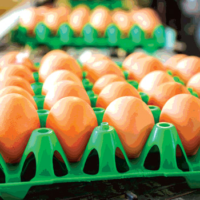Best Sanitizers Inc. is no stranger to trendsetting in the field of sanitation. “We provide sanitizing solutions to between 7,000 and 8,000 food processing and handling operations in the U.S.,” says Ryan Witt, Best Sanitizers’ Vice President-Sales & Marketing, who notes that the company is expanding its North American factory and will enter the Latin American market this year. “Our customers have a lot at stake in terms of assuring food safety for their customers, so we are constantly enhancing our products in order to meet that critical need.”
Leaders in alcohol sanitizing solutions for the food industry, Best Sanitizers has been formulating some of the most innovative products on the market since 1995. The company was the first to introduce an E3 rated, alcohol-based hand sanitizer to food processors and foodservice operations as a way to significantly reduce the spread of pathogens between employees and on the production floor. Best Sanitizers’ Alpet D2 Surface Sanitizer/Disinfectant was the first ready-to-use alcohol-based surface sanitizer introduced to the industry and among the first disinfectants to receive an Environmental Protection Agency (EPA) efficacy claim against Norovirus.
The importance of these products to the industry has been complemented by the company’s innovations in its hand sanitizer dispensing systems. From battery-operated infrared units to industrial-strength foot- and wrist-operated stainless steel models, Best Sanitizers has designed these systems to dispense sanitizers reliably and economically.
“Engineering new products and improving delivery systems requires staying on top of the trends to meet the ever-changing sanitation needs and requirements of food plants and foodservice outlets,” Witt says. “As we expand our product line and grow into new markets, we expect to continue our tradition of innovation.”
Top Trends Set to Clean Up in the Food Industry
Best Sanitizers has identified some of the latest advances in proper hand hygiene and surface disinfection, adds Witt, that are in demand by food processors and foodservice operators looking to improve the efficacy of these critical steps as part of their sanitation programs. The top three sanitation aids for the food industry to look for in 2008 are:
1. Foaming Soaps. These types of soap products have captured the consumer market and are on the way to becoming the food industry’s soap style of choice. With a foaming soap, the user experiences a lather more quickly than with regular liquid soaps and rinsing the product off of one’s hands also takes place with more ease. Foaming soap also engenders a perception of a cleaner facility since the the use of foam prevents many of the drippy messes caused by liquid soap. Food processors and foodservice operators looking to improve employee handwashing compliance rates and wash area appearance can now find foaming soap products in industrial-size containers, such as Best Sanitizers’ new Alpet E2 Sanitizing Foam Soap, which yields 5,000 washes per gallon.
2. Alchohol-Based Sanitizing Wipes. The availability to the food industry of another consumer market-leading product, presaturated alcohol-based sanitizing wipes, is just around the corner. Processors and foodservice sanitation crews get the benefit of alcohol’s high pathogen kill rate with the advantages of a fast-acting product that evaporates quickly without a lengthy dwell time or the need to manually wipe off the product after application. Noncorrosive, rinse-free and especially useful for cleaning and sanitizing water-sensitive equipment, alcohol-based sanitizing wipes have been long used in the semiconductor and other cleanroom industries. Best Sanitizers’ soon-to-be released presaturated alcohol-based sanitizing wipes (Alpet D2 Surface Sanitizing Wipes), designed specifically for use in the food industry, can be used to more easily clean and sanitize small and irregularly shaped surfaces found in food industry operations.
3. Unique Dispensing Systems. Hand hygiene and surface sanitation products products won’t do much good without a reliable dispensing system. Studies by industry hand hygiene research organization Handwashing For Life, for example, show that personnel handwashing compliance rates go up when the soap or sanitizer dispensing unit is placed in an easy-to-reach area and is easy to use. Over the years, Best Sanitizers has designed dispensing units with this is mind. Its portable, foot-activated EZ Step remains the most popular of the company’s dispensing systems for the food industry, and the wall-mounted 1-2 Knockout and new wall-mounted EZ Step units are able to dispense both soap and sanitizer, helping food production and handling personnel to achieve the highest level of hand cleanliness. In the coming months, Best Sanitizers will release a 2-liter wall-mounted manual dispenser that will dispense either foaming soap or a hand sanitizer spray.
“Although we are talking about trends in hand and surface sanitation,” says Witt, “the fact is that in food processing and foodservice operations clean hands and surfaces are not ‘trendy.’ Cleaning and sanitizing tasks are among the most critical aspects of any comprehensive sanitation program’s success and the tools we use to accomplish those tasks are only as effective as the user’s understanding of how to apply them properly. Our advice to food industry customers is to identify the sanitation trends in their own operations and target applications that will reap the highest level of employee hygiene and production line cleanliness for a true food safety benefit.”
www.bestsanitizers.com
Trendsetting Sanitation: A Look at What’s In




